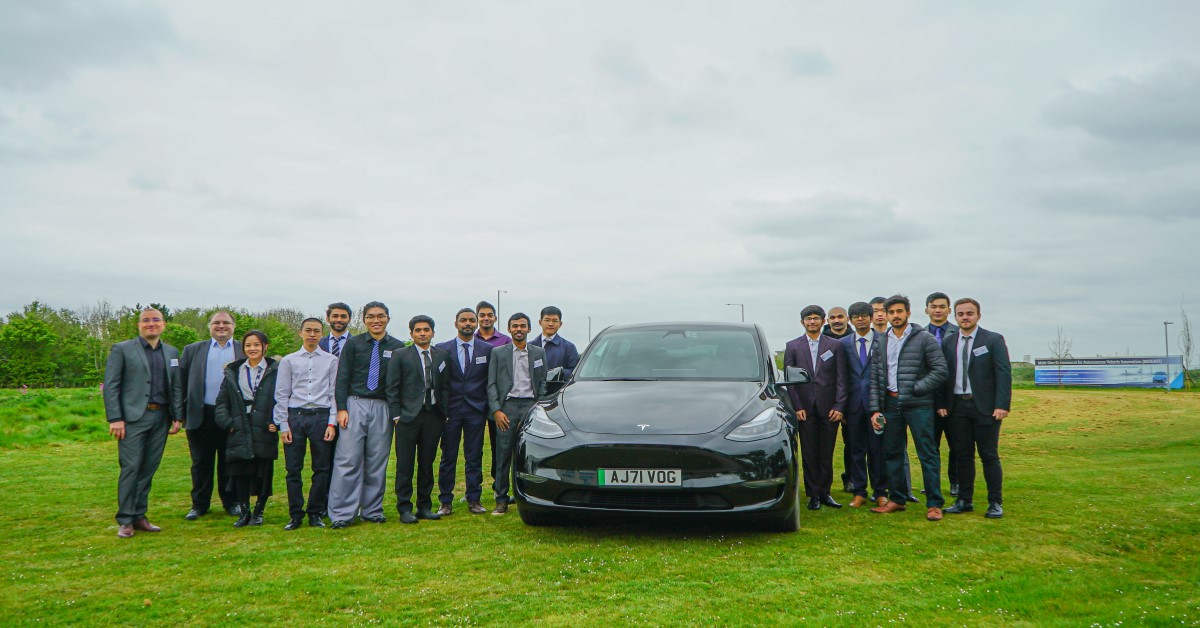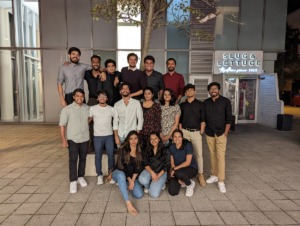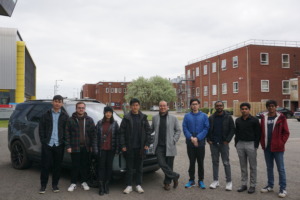Connected and Autonomous Vehicle Engineering (Automotive) MSc alumnus Nirmal Jose: My experience at Cranfield and my career so far
05/06/2023

Nirmal Jose completed the Connected and Autonomous Vehicle Engineering (Automotive) (CAVE) MSc in 2022. Here he talks about why the automotive industry is such an exciting place to be, his experience of studying at Cranfield, and his career to date.
What sparked your interest in the automotive industry?
“As an engineer passionate about technology and automobiles, the rapidly advancing nature of technology in the automotive industry has been a major factor in sparking my interest. The automotive industry is undergoing a transformative period where new technologies, such as electric vehicles, autonomous driving systems, and advanced safety features, are reshaping the way we perceive and interact with automobiles.
“The convergence of cutting-edge technologies, such as artificial intelligence, machine learning, and connectivity, has opened up new possibilities for innovation within the automotive sector. These advancements are improving the performance and efficiency of vehicles and enhancing the overall driving experience and safety for consumers.
“The combination of technological advancements, the opportunity for innovation, the impact on sustainable transportation, and the multidisciplinary nature of the automotive industry have ignited my interest as an engineer. I am excited to be part of this dynamic field and contribute to shaping the future of mobility.”
Why did you choose Cranfield and the CAVE MSc programme?
“I chose Cranfield University for several reasons, particularly its specialisation in automotive and transport systems. Cranfield is renowned for its expertise in this domain. Studying in an institution with such a focus will give me a comprehensive understanding of the automotive industry and equip me with the necessary skills to excel in this field.
“As a postgraduate and research-oriented university, Cranfield offers unique advantages to its students. The emphasis on research allows for a more in-depth exploration of topics and encourages critical thinking and problem-solving abilities. The university’s research resources and facilities provide opportunities for hands-on experience and exposure to cutting-edge technologies and advancements in the automotive sector.
“Cranfield University has built a strong reputation in the transport systems domain globally. Its partnerships with industry leaders, collaborations with research institutions, and involvement in industry projects further enhance its standing. By choosing Cranfield, I can leverage this reputation and benefit from the university’s extensive network and industry connections.
“The CAVE MSc programme at Cranfield University particularly attracted me due to its comprehensive coverage of various aspects of the connected autonomous vehicle field. The course outline ensured that students gained knowledge in essential areas such as artificial intelligence, sensor technologies, vehicle communication systems, cybersecurity, and regulatory aspects. This holistic approach appealed to me as it prepares students to tackle the multidimensional challenges and complexities of connected autonomous vehicles.
“Additionally, the CAVE programme at Cranfield University is designed to stay abreast of the continuously evolving connected autonomous vehicle field. This ensures students are exposed to the latest advancements, emerging trends, and industry best practices. This dynamic curriculum aligns with my goal of acquiring up-to-date knowledge and skills in this rapidly changing industry.”
How did you find the course? What were the highlights?
“I found the CAVE course at Cranfield University to be highly fulfilling and comprehensive, meeting my expectations and exceeding them in certain aspects. The course provided a well-rounded introduction to connected autonomous vehicle technologies, algorithms, ethics, and regulation, ensuring that students gained a broad understanding of the field.
“One of the highlights of the course was the distinct modules that covered different aspects of connected autonomous vehicles. Some modules involved individual and group activities, allowing for a deeper understanding of real-world implementation challenges. These activities provided hands-on experience and practical insights into the complexities of implementing connected autonomous vehicle systems. Combining individual and group work fostered collaboration skills and exposed us to diverse perspectives and problem-solving approaches.
“The assessments in the course were particularly noteworthy. They were designed to challenge us to devise solutions and implement them independently to address real-world problems. These assessments pushed us to explore the module content in greater depth, enhancing our understanding of the various topics. The assessments provided valuable learning opportunities and enabled us to apply our knowledge effectively.

“The group design project and individual research project were the standout components of the course. The group design project allowed us to apply the concepts and skills learned in the taught modules to a practical scenario. Working in a time-constrained environment and dealing with various challenges pushed us to our limits and fostered the development of crucial skills such as project management, resource allocation, and time management. The individual research project (thesis) provided an opportunity to delve into an interesting field of choice within connected autonomous vehicles and develop state-of-the-art solutions to real-world problems. This project allowed for deep exploration and contributed to my growth as a researcher and innovator.
“Studying and collaborating with a diverse group of fellow students from various backgrounds and cultures was another aspect I immensely enjoyed. The exchange of ideas, perspectives, and experiences enriched the learning environment and facilitated a holistic understanding of the subject matter. Additionally, being part of the Cranfield Autonomous Vehicle Society, which aimed to raise awareness about connected autonomous vehicles, provided opportunities to network with professionals who shared a common interest in connectivity and automation. These experiences helped me create a valuable professional network and fostered a sense of community within the field.”
What has your career path been since graduating?
“After graduating from Cranfield University, my career path has been advantageous. Even before completing the course, I was fortunate to receive multiple opportunities within the automotive industry.
“Initially, I joined an automotive consulting firm as a research analyst. In this role, I conducted extensive market research and analysis focusing on connected and autonomous vehicles, shared mobility, electric vehicles, and automotive security. My responsibilities included gathering industry insights, identifying trends, and providing strategic recommendations to clients in the automotive and related service sectors. This experience allowed me to apply the knowledge and skills gained during my master’s program and provided a valuable opportunity to contribute to the industry through research and analysis.
“Currently, I am working as a graduate engineer in the connected autonomous vehicles department of an automotive engineering, research, and test facility. This position aligns perfectly with my coursework and practical work at Cranfield University. In this role, I am involved in testing connected autonomous vehicle technologies, including software development, integration, and performance evaluation. I work closely with a team of engineers and researchers to ensure the successful implementation of these technologies. This position allows me to further deepen my expertise in the field while being actively involved in the practical aspects of connected autonomous vehicles.”
Can you tell us more about your role as a Graduate Engineer at HORIBA MIRA?
“As a Graduate Engineer at HORIBA MIRA in the connected autonomous vehicles (CAV) team, my role primarily focuses on the verification and validation of CAV systems. I am involved in supporting the creation of test methodologies for CAV and Advanced Driver Assistance Systems (ADAS) assurance. This includes developing procedures and protocols to ensure CAV systems meet the required standards and regulations.
“One of my key responsibilities is to verify the requirements of CAV systems through various testing and evaluation methods. This involves designing and executing tests to assess the performance, functionality, and safety of connected autonomous vehicles. By analyzing test results, I can identify any system deviations or shortcomings and provide valuable feedback for improvements.
“Validation is another crucial aspect of my role. I will collaborate with cross-functional teams to validate the appropriate performance of CAV systems. This ensures the systems meet the desired functionality, reliability, and safety standards. I will be working on developing and implementing validation plans, conducting tests, and analyzing data to validate the performance of CAV technologies.
“In my role, I am also responsible for delivering innovative and leading solutions that support current and future client CAV development and testing requirements. This involves staying updated with the latest advancements and industry trends in connected autonomous vehicles and integrating them into our testing methodologies. By continuously seeking innovative approaches, we can enhance our services and provide cutting-edge solutions to our clients.”
What does a typical week look like for you?
“A typical week as a Graduate Engineer at HORIBA MIRA involves a combination of various activities related to the verification and validation of connected autonomous vehicles. Much of my time is dedicated to researching testing methods for the verification and validation of connected autonomous vehicles. This involves staying up-to-date with the latest industry developments, academic publications, and emerging technologies. By conducting thorough research, I can gather insights and identify best practices that can be applied to our testing methodologies.
“Another important aspect of my work is the development of a toolchain for verification and validation test services. This involves leveraging software tools and technologies to streamline and automate the testing process. I collaborate with software engineers and other team members to develop efficient and effective tools to test various aspects of connected autonomous vehicles.
“I will be working on planning and executing tests according to the established methodologies and test plans. This includes defining test scenarios, selecting appropriate test cases, and ensuring proper test coverage. I will collaborate with colleagues to set up test environments, conduct test runs, and collect relevant data for analysis. Documenting the work carried out is crucial for maintaining records and ensuring traceability. I spend time documenting the test procedures, test results, analysis findings, and any other relevant information. This documentation serves as a reference for future testing and provides a comprehensive overview of the verification and validation activities undertaken.
“I actively participate in team meetings and discussions to share progress, exchange ideas, and seek input from colleagues. Collaboration with other engineers, researchers, and stakeholders is essential to ensure alignment, address challenges, and identify opportunities for improvement. As a Graduate Engineer, I also dedicate time to my professional development. This may involve attending workshops, training sessions, or webinars to enhance my skills and knowledge in areas relevant to connected autonomous vehicles and verification/validation practices. While the specific activities may vary depending on project requirements and timelines, this overview provides a glimpse into a typical week as a Graduate Engineer at HORIBA MIRA. The work is dynamic, challenging and requires a combination of technical expertise, research capabilities, and collaboration skills to ensure the successful verification and validation of connected autonomous vehicles.”
What would you say to someone who wants to work in the automotive industry?
“The automotive industry is currently undergoing significant advancements and transformations. This makes it an exciting time to enter the field and contribute to the industry’s evolution. The industry is witnessing groundbreaking changes in areas such as electric vehicles, connected and autonomous vehicles, and innovative mobility solutions. By joining the automotive industry, you have the opportunity to be at the forefront of these developments and play a role in shaping the future of transportation.
“To thrive in the automotive industry, it is important to possess a diverse set of skills. The industry is no longer solely focused on traditional mechanical engineering principles. Instead, it demands interdisciplinary knowledge and expertise. Familiarize yourself with software development, electronics, data analytics, cybersecurity, and emerging technologies such as artificial intelligence and machine learning. Understanding the ethical considerations, regulations, safety protocols, and security measures specific to the automotive industry is also crucial. By cultivating a broad skill set, you can adapt to the industry’s evolving needs and contribute to various aspects of automotive development.
“In summary, working in the automotive industry presents an incredible opportunity to contribute to the future of transportation. By developing interdisciplinary skills, pursuing relevant education and practical experience, networking within the industry, staying adaptable, and showcasing your passion, you can position yourself for a fulfilling and rewarding career in this rapidly evolving field.”

What do you think the future holds for the automotive industry?
“The future of the automotive industry holds immense potential and is expected to undergo significant transformations. The industry is moving towards a future with increased electrification. Electric vehicles (EVs) are gaining popularity as technology advances, battery costs decline, and environmental concerns grow. Governments and manufacturers are investing heavily in EV infrastructure and development. Alternative powertrains such as hydrogen fuel cells and hybrids are also being explored as viable options to reduce emissions and enhance sustainability. The automotive industry is witnessing a rapid advancement in connected and autonomous vehicles (CAVs). Vehicle-to-vehicle (V2V) and vehicle-to-infrastructure (V2I) communication technologies are enabling enhanced safety, efficiency, and convenience. Autonomous driving technologies, such as advanced driver-assistance systems (ADAS) and self-driving capabilities, are being developed and tested by various companies. The future holds the potential for fully autonomous vehicles that can navigate without human intervention.
“Safety remains a top priority in the automotive industry. Advanced safety technologies such as adaptive cruise control, lane-keeping assist, and automatic emergency braking are becoming standard vehicle features. With the increased connectivity and autonomy, cybersecurity measures are crucial to protect vehicles from potential threats.
“The concept of mobility as a service is gaining traction, shifting the focus from individual vehicle ownership to shared mobility solutions. Ride-hailing, car-sharing, and subscription-based models are becoming more prevalent, providing flexible and convenient transportation options. The integration of CAVs and MaaS is expected to revolutionize urban mobility, reducing congestion and improving accessibility. The automotive industry is embracing digitalization and connectivity, leading to various innovations. Internet of Things (IoT) technology is enabling vehicles to connect with other devices, infrastructure, and the cloud. This connectivity facilitates real-time data collection, vehicle diagnostics, over-the-air updates, and personalized user experiences. Digital platforms, applications, and services are being developed to enhance the driving experience and provide value-added services.
“The industry is increasingly focused on sustainability and reducing its environmental impact. Overall, the future of the automotive industry holds immense opportunities for innovation, sustainability, and enhanced mobility experiences. Investments in electrical and software-defined vehicles, along with emerging technologies like connectivity, autonomy, and mobility services, will continue to shape the industry. Young professionals who invest in gaining expertise in these areas, remain adaptable and embrace lifelong learning will be well-positioned to thrive in the dynamic automotive landscape of the future.”
Categories & Tags:
Leave a comment on this post:
You might also like…
Preparing your work for Turnitin submission
Before submitting your work into Turnitin for similarity checking, if you have used referencing software then you may need to take some important steps first. Mendeley and Zotero integrate with MS Word by embedding field ...
The fast track to supercar engineering: My Cranfield journey
It’s been a dream come true to work on some of the world’s most prestigious supercars – the Aston Martin Valhalla, McLaren 750 & Artura, the GMA T.33. But every successful ...
Automotive Engineering: From student to hypercar innovation at Rimac
We sat down with recent graduate Thomas Perrin, to discuss how his year on the MSc in Automotive Engineering at Cranfield University propelled him from the lecture hall directly into the ...
What this year at Cranfield really meant to me
Every Cranfield journey is unique. In this alumni reflection, Zachea Scicluna shares what her year at Cranfield truly meant, from facing uncertainty to gaining hands-on experience in industry-backed projects. I’ve been reflecting (and delaying) ...
Preparing for assignments and exams?
Sorry! We know it seems a bit mean to mention the exams in January rather than looking forward to the break before it! However, we know many of you will be thinking about your forthcoming ...
Screening for FTSE 100 companies on Bloomberg
So you’re researching an index and need some data on its constituent companies? Bloomberg’s Equity Screening tool makes light work of this, not just for the FTSE, but for indices, exchanges and sectors worldwide. Type EQS ...






